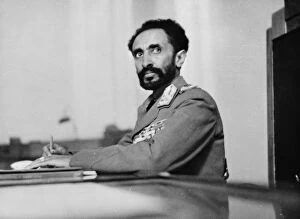Selassie Collection (#2)
"Selassie: The Iconic Emperor of Ethiopia" Haile Selassie, also known as Ras Tafari, ascended to the throne in 1930, becoming the crowned emperor of Ethiopia
For sale as Licensed Images
Choose your image, Select your licence and Download the media
"Selassie: The Iconic Emperor of Ethiopia" Haile Selassie, also known as Ras Tafari, ascended to the throne in 1930, becoming the crowned emperor of Ethiopia. His coronation marked a significant moment in history, symbolizing the resilience and strength of his nation. In 1936, during the Italian invasion led by Benito Mussolini's forces, Haile Selassie faced immense challenges. Despite being exiled from his own country for several years, he never lost hope and continued to fight for Ethiopian independence. Returning triumphantly after World War II in 1941, Haile Selassie was welcomed with applause and admiration from his people. His leadership skills were evident as he worked tirelessly to rebuild Ethiopia and restore its sovereignty. The international community recognized Haile Selassie's influence when Queen Elizabeth II and Prince Philip visited the Ethiopian Embassy. Their arrival showcased the respect bestowed upon this remarkable leader who had captured hearts worldwide. Throughout his reign as emperor, Haile Selassie remained committed to improving conditions for his citizens. He implemented various reforms that aimed at modernizing Ethiopia while preserving its rich cultural heritage. Before ascending to power, Haile Selassie served as Crown Prince and Regent of the Ethiopian Empire from 1916 to 1928. This period allowed him to gain valuable experience and prepare himself for future challenges that lay ahead. During a visit by the Duke of York (later King George VI) in 1924, Ras Tafari impressed with his intelligence and vision for Ethiopia's future. This encounter further solidified international recognition of his potential as a great leader. In Geneva in 1936, an iconic demonstration took place against Italy's aggression towards Ethiopia under Haile Selassie's rule. This event highlighted not only his determination but also galvanized global support for justice and equality.







